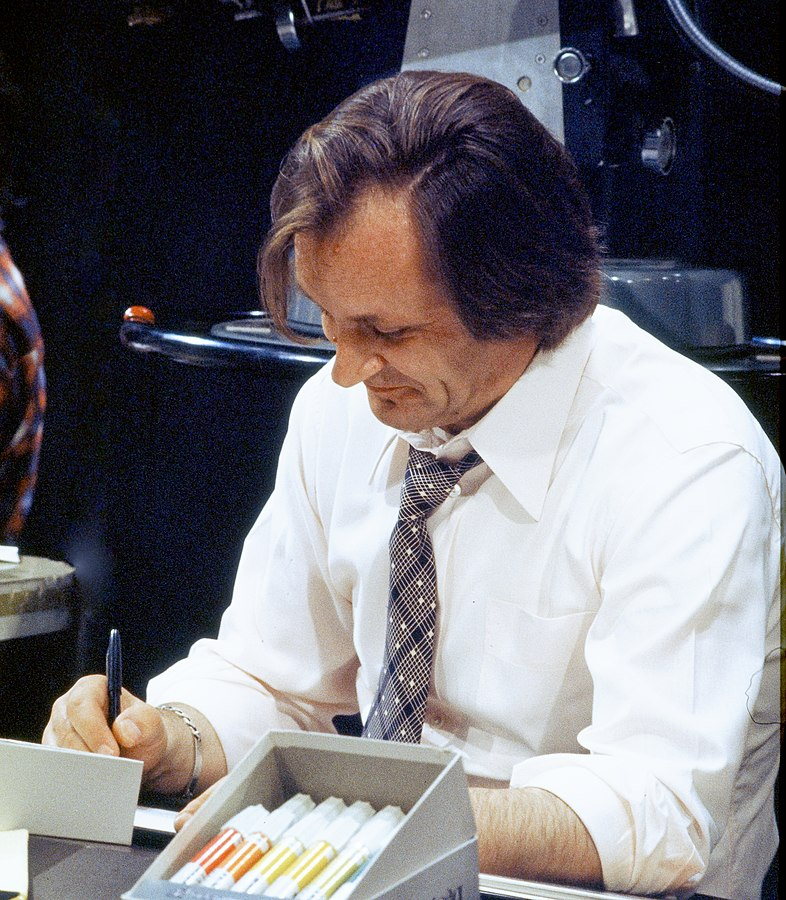Title of the work
Country of the First Edition
Country/countries of popularity
Original Language
First Edition Date
First Edition Details
René Goscinny, Albert Uderzo, Astérix et Cléopâtre. Paris: Darguad, 1968, 48 pp.
ISBN
Genre
Comics (Graphic works)
Target Audience
Children (and Young Adults)
Cover

We are still trying to obtain permission for posting the original cover.
Author of the Entry:
Agnieszka Maciejewska, University od Warsaw, agnieszka.maciejewska@student.uw.edu.pl
Peer-reviewer of the Entry:
Elżbieta Olechowska, University of Warsaw, elzbieta.olechowska@gmail.com
Susan Deacy, University of Roehampton, s.deacy@roehampton.ac.uk
René Goscinny
, 1926 - 1977
(Author)
René Goscinny was born in 1926 in Paris. He was the son of Jewish immigrants to France from Poland. Born in Paris, he moved with his family to Buenos Aires, Argentina, at the age of two. In 1943 he was forced into work by his father’s death, eventually gaining work as an illustrator in an advertising firm. Living in New York by 1945, Goscinny was approaching the usual age of compulsory military service. However, rather than join the United States Army, he elected to return to his native France to complete its year-long period of service. Throughout 1946, Goscinny was with the 141st Alpine Infantry Battalion, and found an artistic outlet in the unit’s official and semi-official posters and comics. His first commissioned illustrated work followed in 1947, but he then entered into a period of hardship upon moving back to New York City. Some important networking occurred thereafter with other emerging comic artists, before Goscinny returned to France in 1951 to work at the World Press Agency. There, he met lifelong collaborator, Albert Uderzo, with whom he co-founded the Édipresse/Édifrance syndicate and began publishing original material.
As Edipresse/Edifrance developed, Goscinny continued to work across a number of publications in the 1950s, including Tintin magazine from 1956. A key output from this period was a collaboration with Maurice De Bevere (1923–2001). They created together series of comics: about Lucky Luke (with Maurice), and about Asterix (with Uderzo). Goscinny worked with Jean Jacques Sempe and they created a series about boy called Nicolas.
The following year (1959), the syndicate launched its own magazine, Pilote; and the first issue contained the earliest adventure of ‘Astérix, the Gaul’, scripted by Goscinny himself, and drawn by Uderzo. On the back of Astérix, Pilote was a huge success, but managing a magazine was a challenge for the members of the syndicate. Georges Dargaud (1911–1990) – publisher of Tintin, and a major force in Franco-Belgian comics – saw the opportunity to purchase Pilote in 1960, and put it on a firmer footing, financially. Already the leading script-writer on the magazine, Goscinny was co-editor-in-chief of Pilote from 1960. Such was its success that by 1962, he was able to leave Tintin magazine in to edit Pilote full-time, and he held that role until 1973.
Goscinny’s success with Astérix and Lucky Luke (published in serialized instalments in the magazine, as well as in album-form by Dargaud) saw him enjoy a comfortable life, but this arguably contributed to his growing ill-health. He had married in 1967 – to Gilberte Pollaro-Millo – and a daughter – Anne Goscinny – was born the following year, as he continued to work with Uderzo and others. Pilote and Astérix were sufficiently profitable to be a full-time job, and twenty-three Astérix adventures were completed by 1977, when Goscinny died suddenly of a cardiac arrest during a routine stress test. Uderzo completed the story Astérix chez les Belges [Asterix in Belgium] and continued the series alone.
Goscinny was not only a comic book author but also a director and co–director of animated movies (Daisy Town, Asterix and Cleopatra), feature movies (Les Gaspards, Le Viager). Goscinny. He died in 1977 in Paris.
Sources:
bookreports.info (accessed: September 14, 2018)
britannica.com (accessed: September 14, 2018)
lambiek.net (accessed: September 14, 2018)
Bio prepared by Agnieszka Maciejewska, University of Warsaw, agnieszka.maciejewska@student.uw.edu.pl and Richard Scully, University of New England, Armidale rscully@une.edu.au

Albert Uderzo in 1973 by Gilles Desjardins. Retrieved from Wikimedia Commons, licensed under CC BY-SA 4.0 (accessed: December 30, 2021).
Albert Uderzo
, 1927 - 2020
(Illustrator)
Albert Uderzo was born in Fismes, France, in 1927. The son of Italian immigrants, he experienced discrimination following the family’s move to Paris, at a time when Fascist Italy was pursuing an aggressive course, internationally (on top of the usual xenophobia directed at immigrants). Uderzo came into contact with American-imported comics around the late 1930s (including Mickey Mouse and Donald Duck). He also discovered that he was colour-blind (despite art being the only successful aspect of his schooling career). Living in German-occupied France, from 1940, Uderzo tried his hand at aircraft engineering, but illustration was where he found his métier. Post-war, he came into contact with the circles of Belgian-French comics artists; as well as meeting and marrying Ada Milani in 1953 (who gave birth to a daughter, Sylvie Uderzo in 1953).
He started his career as an illustrator after World War II. In 1951, he met René Goscinny at the World Press Agency. Together, they worked on a comic: ‘Oumpah-pah le Peau-Rouge’ [Ompa-pa the Redskin] – drawn by Uderzo and written by Goscinny. In 1959 Uderzo and Goscinny were editors of Pilote magazine. They published there their first Asterix episode which became one of the most famous comic stories in history. Individual albums of Astérix adventures appeared regularly from 1961 (published by Georges Dargaud following the completion of the serialized run in Pilote), and there were 23 completed adventures by the time Goscinny died in mid-1977. After Goscinny’s death, Uderzo took over the writing and continued publishing Asterix adventures, and completed 11 further albums by retirement in 2011 (including several that were compendiums of older material, co-created by Goscinny). In the late 2000s and early 2010s, Uderzo experienced considerable family disquiet; largely over the financial benefits expected to accrue to his daughter. Although maintaining for much of his career that Astérix would end with his death, he agreed to sell his interest in the character to Hachette Livre, who has continued the series since 2011, owing to the talents of Jean-Yves Ferri and Didier Conrad.
All stories about Asterix published till now are very successful and widely known. They are highly popular not only in France but have been translated into one hundred and ten languages and dialects. The series continues and Asterix (Le papyrus de Cesar) became the number one bestseller in France in 2015 with 1,619,000 copies sold. The sales figures and popularity of Asterix series are comparable with the Harry Potter phenomenon. Astérix et la Transitalique published in “2017 placed 76 among the French Amazon best sellers three weeks before it was published Among comic books for adolescents the title was number one, among comic books of all categories it was number two.”*
Albert Uderzo died on 24 March 2020.
Sources:
lambiek.net (accessed September 14, 2018).
Bio prepared by Agnieszka Maciejewska, University of Warsaw, agnieszka.maciejewska@student.uw.edu.pl and Richard Scully, University of New England, Armidale rscully@une.edu.au
*See Elżbieta Olechowska, “New Mythological Hybrids Are Born in Bande Dessinée: Greek Myths as Seen by Joann Sfar and Christophe Blain” in Katarzyna Marciniak, ed., Chasing Mythical Beasts…The Reception of Creatures from Graeco-Roman Mythology in Children’s & Young Adults’ Culture as a Transformation Marker, forthcoming.
Adaptations
The movie Cleopatra, dir. Joseph L. Mankiewicz, from 1963 with Elizabeth Taylor as Cleopatra, purely based on historical events, was the direct inspiration for the authors.
The animation Asterix and Cleopatra, realised by René Goscinny and Albert Uderzo, Belvision, Dargaud Films, 1968, 72 min.
The movie Astérix & Obélix: Mission Cléopâtre [Asterix & Obelix: Mission Cleopatra], dir. Alain Chabat, 2002, 107 min.
Summary
Asterix and Cleopatra is the 6th part of the series about a brave Gaul and his friends. Every story and series have similar outline. Smart Asterix and strong Obelix obtain enourmous power thanks to magical potion prepared by Panoramix an old druid. Magic potion helps to fight the Romanians. Asterix and Cleopatra begins with an unexpected visit of an architect named Numerobis from Alexandria. He interrupts the Gaul’s daily routine to ask for help in building a palace in Alexandria. His Queen Cleopatra bet with Julius Caesar that Egyptians would build the palace in three months. Asterix, Obelix, and Panoramix along with their dog Idéfix decide to help Numerobis and set out for Egypt, where they prepare a magical potion which gives enormous strength. Drinking that potion allows them to build the palace very quickly. A second architect, jealous about this success, doesn’t let the construction proceed and creates many intrigues to interrupt the work. Caesar also doesn’t want the construction to succeed; he attacks and destroys the new palace. At that time Cleopatra arrives in Alexandria, talks to Caesar and puts the work back on track so the palace can be finished on time.
Analysis
Asterix and Cleopatra is one of the most popular stories about Asterix the Gaul. It describes in a humorous way the times of Cleopatra and Julius Caesar, who initiate the whole adventure in this story. Cleopatra is shown as a very confident woman, who knows what she wants. She doesn’t see herself as a ruler inferior to Julius Caesar or any other. She is very strong and proud as a Queen. Cleopatra also has very strict moral rules when it comes to her employees. They get rewarded for getting the work done well and punished with death if they fail. Her employees get eaten by crocodiles. She has a very specific appearance. She is small, with a snub nose, a jeweled wig, and a headband with a cobra motive “The Royal Ureus” a symbol of a royalty and deity. Depiction of her make up in this book might have influenced famous movie Cleopatra from 1963 with Elizabeth Taylor in the lead role. Elizabeth Taylor’s make up is very similar to the one we can see in the comic book about Cleopatra. The colors and the oriental kohl line on her eyelids are the same. This makeup was a huge inspiration for many women in the 1960s
Julius Caesar is shown as a man who always must be right and wants to win no matter what the costs are. To win the bet with Cleopatra he attacks the construction site to destroy the nearly-finished palace. Although he is so powerful he is afraid of his beloved Cleopatra and her reactions so he is very gentle, when she is around. Caesar’s appearance is very similar to the historical representations of him from the ancient times.
Readers meet not only the two historical and famous characters but also learn about culture of Ancient Egypt. This comic book represents a wide spectrum of art (pyramids, Sphinx, reliefs) and also describes well relations between the ruler and his minions and slaves. We can also learn how Cleopatra’s country functioned and how it was developing. We can also get to know about people’s daily routine, what they ate and how they took care of their personal hygiene (famous Cleopatra bath). Popular opinion about her famous bath is that she used to take baths in donkey’s or goat’s milk to have beautiful, smooth and delicate skin. This motive was emphasized in animation from 1968 Asterix and Cleopatra and also animation from 2002 Asterix and Obelix: Mission Cleopatra. In these days many cosmetics based on milk promise to have a smooth and delicate skin like Queen Cleopatra.
Asterix has a very unique and humorous reception of Antiquity and refers to French patriotic feelings with an early national history which makes the whole series so irresistible and loved among readers. The series of comic albums about Asterix is one of the best known in the world.
Addenda
It was first published in the Pilote magazine, issues 215–257, in 1963, en.wikipedia.org (accessed: September 14, 2018).



